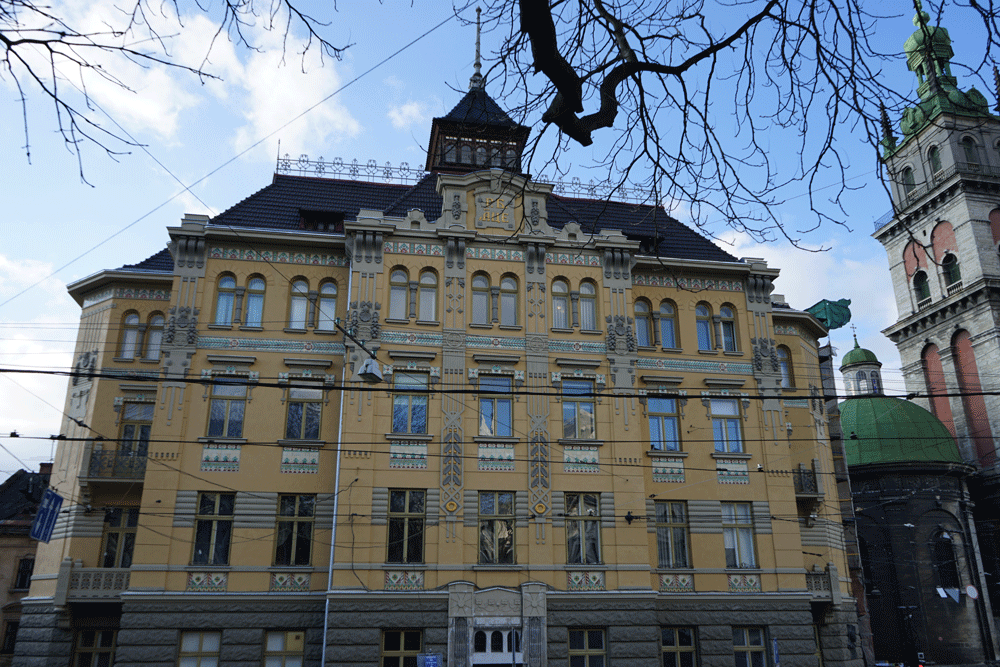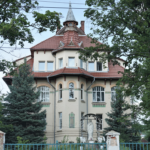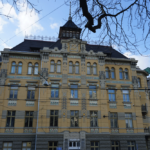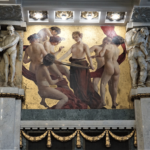In the flourishing period of Secession (the end of 19th – early 20th centuries), Lviv was the capital of the Kingdom of Galicia and Lodomeria within the Austro-Hungarian Empire. The city was actively developing. The discovery of oil and gas fields in the mid-19th century in the Precarpathian region contributed to the opening of foreign banks’ offices in Lviv. The development of educational institutions required the construction of dormitories for students. The populationof the city was quickly increasing. All this led to a construction boom in Lviv, which was accompanied by a pursuit for a new style. For the first time in the history of construction in Lviv, the new style came into fashion without delay, synchronously with its appearance in Europe. It got the name Secession, as it was called in Austro-Hungarian Empire. Secession in Lviv developed in two directions: international, which imitated the European features of this style, and national, which reflected on the folk architecture of different nationalities living in Lviv at that time: Poles, Jews, and Ukrainians. So, the multinationality of Lviv was reflected in its architecture. For example, architect and entrepreneur Ivan Levynskyi founded an architectural bureau in 1881, bringing together a whole pleiad of young architects who designed numerous buildings in Hutsul Secession style, such as the Dnister Insurance Company, the Gymnasium of Ukrainian Pedagogical Society, etc. Motifs of the Zakopane (Polish folk) style were also popular in Lviv. Villa of L. Heller, Villa Maria of N. Luszkiewicz, and a number of tenement houses have Zakopane features expressed in rich carved wooden decor and solar signs. The Jewish Secession was characterised by oriental ornaments, the wavy shape of the attics, and other features related to religious traditions.
Meanwhile, the international trend evolved from the ornamental Secession (floral stucco ornaments), to rational Secession (majolica panels), and late Secession (retrospective historicism). Secession in Lviv lasted from 1898 until the World War I. After the WWI, the Secession continued only in the works of J. H. Rosen, who created Secessionist paintings in the Armenian Cathedral 1925-1929.
| Image | artist | function | date |
|---|---|---|---|
| Ivan Levynskiy | Architect | 1851-1918 | |
| Tadeusz Obmiński | Architect | 1874 – 1932 | |
| Oleksandr Lushpynskyi | Architect | 1878 – 1943/1944 | |
| Alfred Zachariewicz | Architect | 1871 – 1937 | |
| August Bogochwalski | Architect | 1864 – 1909 | |
| Zygmunt Kurczyński | Sculptor | 1886 – 1954 | |
| Piotr Wojtowicz | Sculptor | 1862 – 1938 | |
| Jan Henryk Rosen | Painter | 1891-1982 | |
| Feliks Wygrzywalski | Painter | 1875 – 1944 | |
| Modest Sosenko | Painter | (1875 – 1920 | |
| Jan Daschek | Blacksmith | 1837 – 1904 | |
| Mykhailo Stefanivskyi | Blacksmith | 1878 – 1952 |
| Cover | Author | Description | date | Link |
|---|---|---|---|---|
| Yuriy Biriulov | Мистецтво львівської сецесії Центр Європи (Center of Europe) ISBN: 978-966-7022-44-7 |
|||
| Yuriy Biriulov | Sur les traces de l’Art Nouveau en Ukraine: Kiev et Lviv / Пам’ятки стилю модерн в Україні: Київ та Львів CIVA ISBN: 2-930391-37-5 |
|||
| Oleksandr Noha | Іван Левинський: архітектор, підприємець, меценат Центр Європи (Center of Europe) ISBN: 978-966-7022-81-5 |
|||
| A. Klimashevskyi | Керамічний код Івана Левинського в естетичному вимірі українця кінця XIX – початку XX ст ISBN: 978-966-02-9387-8, 978-617-7691-11-1, 978-966-02-9386-1 (серія) |
|||
| Żanna Komar, Julia Bogdanowa | Secesja we Lwowie Wysoki Zamek ISBN: 9788393958627 |
Partner :
Lviv Heritage bureau
20 Valova St., Lviv 79008, UKRAINE
Phone: +38 0322 975 132
Mail: lkpheritage@gmail.com
Contact person: Yana Terletska – yanaheritage.lviv@gmail.com


























































